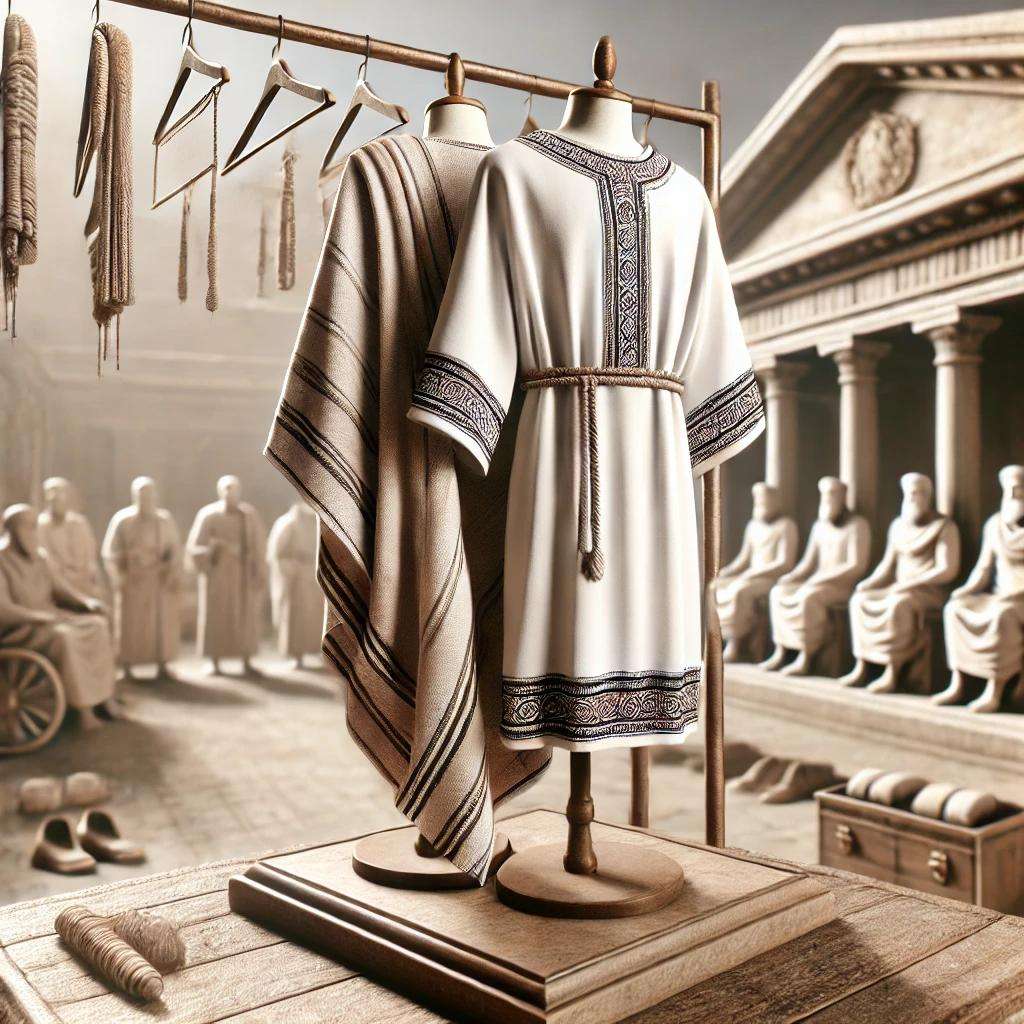
Ever wondered what does the Bible say about clothing? It’s a topic that might surprise you with its depth and relevance. From modesty to symbolism, the Bible offers insights into how clothing can reflect your values and beliefs.
You’ll find passages that speak to both practical advice and spiritual lessons. Whether you’re curious about historical context or seeking guidance for modern-day fashion choices, exploring what the Bible says about clothing can provide a meaningful perspective on how you present yourself to the world.
What Does the Bible Say About Clothing:
Historical Context of Clothing in the Bible
Ancient Israeli Garments
Ancient Israeli garments were simple and functional. Men’s clothing typically included a tunic, belt, and sandals, while women wore longer tunics with additional veils or shawls. Materials like wool, linen, and leather were common due to their availability (Source: Encyclopedia of the Bible). These garments often indicated one’s social status and role within the community.
Symbolism And Significance
Clothing in biblical times held symbolic meanings. Sackcloth was worn during mourning or repentance (Genesis 37:34), indicating sorrow or humility. Priestly garments described in Exodus 28 had specific designs symbolizing holiness and service to God. Purple cloth signified wealth or royalty (Judges 8:26), reflecting one’s position in society.
Cultural Influences
Cultural influences impacted clothing styles in biblical times. Trade routes introduced new materials and fashions from neighboring regions such as Egypt and Mesopotamia (Source: Biblical Archaeology Society). This exchange influenced how people dressed, incorporating diverse elements into their traditional attire.
Regulations And Restrictions
The Bible contains explicit regulations on clothing for religious purposes. Deuteronomy 22:11 prohibits wearing clothes made of both wool and linen together. Leviticus 19:19 mentions not mixing different kinds of fibers as part of broader purity laws aimed at maintaining distinctiveness among God’s people.
How Understanding Historical Context Enhances Comprehension Of What Does The Bible Say About Clothing
Understanding the historical context enhances comprehension when exploring “what does the bible say about clothing.” Knowing ancient customs helps you grasp why certain materials or styles were significant. It provides insight into how scriptural teachings on modesty, humility, and identity through apparel apply today.
Old Testament Views On Clothing
The Old Testament provides detailed insights into clothing’s significance. From the first garments worn by Adam and Eve to the symbolic use of sackcloth and linen, these texts show how clothing can reflect deeper values.
Adam And Eve: The First Clothes
Genesis describes how God made garments of skin for Adam and Eve after they sinned. These clothes signified a transition from innocence to awareness, highlighting humanity’s need for protection and modesty. This act also marked the beginning of using clothing as a means to cover one’s body, emphasizing that what does the Bible say about clothing starts with divine intervention.
Symbolism Of Sackcloth And Linen
Sackcloth, often made from goat hair, symbolized mourning or repentance in biblical times. For instance, people wore sackcloth during periods of grief or penance (e.g., King David). Linen represented purity and holiness; priests wore it during religious ceremonies to signify their sacred duties. By understanding these symbols, you gain insight into how different fabrics conveyed messages beyond their physical properties.
Through these examples—Adam and Eve’s first clothes and the symbolic use of sackcloth and linen—the Old Testament reveals deep connections between faith, identity, and apparel.
New Testament Perspectives On Clothing
Teachings Of Jesus
Jesus emphasized internal virtues over external appearances. In Matthew 6:28-30, He pointed out the lilies of the field, stating they were better adorned than Solomon in all his glory. This passage suggests that God values natural beauty and provision over human attempts at adornment.
Additionally, Jesus criticized religious leaders for their ostentatious clothing meant to display piety (Matthew 23:5). He urged followers to focus on humility and inner purity rather than seeking validation through elaborate garments. These teachings underscore a shift from external adornment to a heart-centered faith.
Modesty And Simplicity
The New Testament advocates for modesty and simplicity in dress. Paul, in 1 Timothy 2:9-10, advised women to dress modestly with decency and propriety, not with elaborate hairstyles or gold ornaments but with good deeds appropriate for women who profess worship of God.
Peter echoed this sentiment in 1 Peter 3:3-4 by encouraging women to let their beauty come from within rather than relying on outward adornments like braided hair or fine clothes. Such directives highlight the importance of character over appearance when considering what does the Bible say about clothing.
These passages collectively advocate for an approach that values inner qualities and godliness above materialistic expressions through attire.
Clothing As A Symbol Of Identity And Status
In biblical times, clothing often symbolized one’s identity and status. It wasn’t just for protection or modesty; it conveyed deeper meanings about a person’s role and place in society.
Priestly Garments
Priestly garments, as described in Exodus 28:2-4, represented holiness and service to God. The high priest wore an ephod, a breastplate with twelve stones representing the tribes of Israel, and a turban with a gold plate inscribed with “Holy to the Lord”. These items signified their sacred duty and unique position among the Israelites. In Leviticus 8:30, Moses consecrated Aaron by sprinkling oil on his garments, highlighting their sanctity.
Royal Robes And Their Significance
Royal robes indicated power and authority. Kings like Solomon wore luxurious fabrics such as purple cloth (a symbol of wealth and royalty), exemplifying their high status (1 Kings 10:4-5). In Esther 6:8-9, Mordecai’s honor involved wearing the king’s robe—a clear marker of prestige. Jesus’ mockery during His trial included dressing Him in royal purple (Mark 15:17), acknowledging His perceived kingship even in scorn.
What Does The Bible Say About Clothing And Social Distinction?
The Bible underscores how clothing can reflect social distinctions. For instance, Joseph’s coat of many colors marked him as Jacob’s favored son (Genesis 37:3). Conversely, sackcloth was worn during mourning or repentance (Jonah 3:5), indicating humility or sorrow across all societal levels. By understanding these contexts when asking what does the bible say about clothing, you grasp its role beyond mere attire—it’s integral to conveying faith-based values and social dynamics.
Modern Interpretations Of Biblical Teachings On Clothing
Modern interpretations of biblical teachings on clothing vary across Christian communities. These views often balance scriptural principles with contemporary cultural contexts.
Contemporary Christian Attitudes
Contemporary Christian attitudes toward clothing often focus on modesty and respect for God’s creation. Many Christians believe that while the Bible emphasizes modest attire, it doesn’t prescribe specific garments. For example, 1 Timothy 2:9-10 encourages women to dress modestly without drawing undue attention to themselves. This principle translates into a variety of clothing styles that prioritize decency over extravagance.
In some denominations, such as conservative Evangelical groups, you’ll find stricter guidelines on what constitutes appropriate attire. These guidelines might include wearing long skirts or avoiding certain types of fabric. However, more liberal denominations may adopt a broader interpretation, focusing instead on the intent behind one’s choice of clothing rather than the actual items worn.
Cultural Variations
Cultural variations significantly influence how biblical teachings on clothing are interpreted and practiced today. In African Christian communities, traditional garments often blend with modern apparel while still adhering to principles of modesty and respect outlined in scripture. Similarly in Asian cultures where traditional attire like the sari or kimono is common you’ll see these integrated into worship settings as expressions of cultural identity aligned with biblical values.
Western cultures exhibit diverse practices ranging from casual church wear to formal Sunday best depending on denominational norms and individual preferences. The central theme remains adherence to scriptural guidance about humility and reverence whether one wears jeans or a three-piece suit.
By considering these contemporary attitudes and cultural variations you can better understand “what does the bible say about clothing” within different contexts today.
Conclusion:
What Does the Bible Say About Clothing?
Understanding what the Bible says about clothing offers a rich tapestry of insights into faith, identity, and cultural contexts. While historical garments conveyed clear messages of status and roles, modern interpretations vary widely across Christian communities. Whether you adhere to strict guidelines or embrace a more liberal approach, the key is aligning your choices with respect for God and His creation. As you navigate these teachings consider how they reflect your faith and personal values in today’s diverse world.
Frequently Asked Questions:
What Does the Bible Say About Clothing?
What is the significance of clothing in the Bible?
Clothing in the Bible conveys messages of identity, status, and societal roles. It symbolizes various aspects such as priestly duties, royal authority, and personal transformation within biblical narratives.
How are priestly garments symbolized in the Bible?
Priestly garments symbolize holiness and dedication to God. They were meticulously designed to reflect purity, service, and a direct connection with divine commandments.
What role do royal robes play in biblical stories?
Royal robes signify authority, power, and legitimacy. They often mark individuals chosen by God for leadership or special missions.
How do modern Christian communities interpret biblical teachings on clothing?
Modern Christian interpretations vary widely. Conservative Evangelical groups often have stricter guidelines focusing on modesty, while more liberal denominations emphasize the intent behind clothing choices rather than specific rules.
How does culture influence biblical teachings on clothing today?
Cultural variations significantly influence how biblical teachings on clothing are interpreted and practiced. Examples from African, Asian, and Western Christian communities show diverse applications reflecting each culture’s unique values and traditions.
Why is modesty emphasized in certain Christian denominations regarding attire?
Modesty is emphasized to reflect respect for oneself and others as creations of God. It aims to uphold principles of humility and dignity within personal appearance.
Are there universal guidelines for Christian attire based on the Bible?
There are no universally accepted guidelines; interpretations differ among denominations. Each community may establish its own standards based on scriptural principles relevant to their cultural context.
Do all Christians follow strict dress codes based on biblical teachings?
No, not all Christians adhere to strict dress codes. Practices range from highly regulated attire in conservative groups to more flexible approaches that focus on individual intent rather than specific rules.
